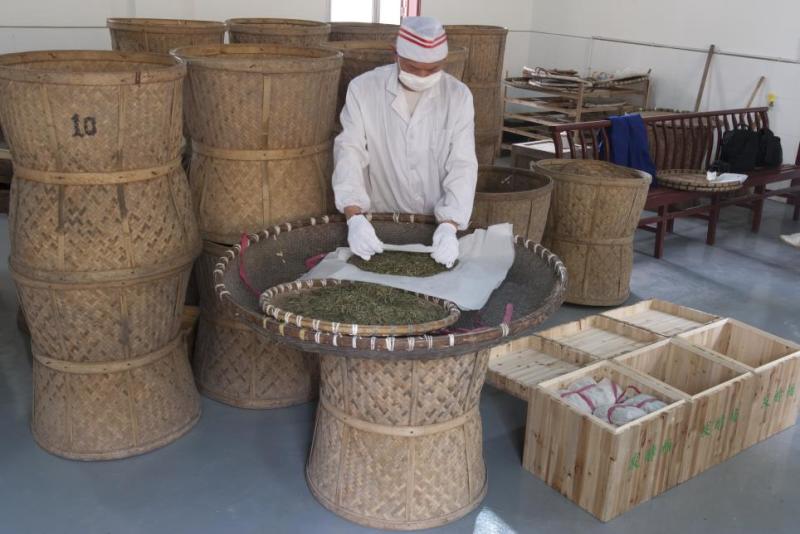Shi Feng Long Jing
Spring teas arriving brings a lot of joy to our little warehouse in the desert. It is bittersweet this year because of the passing of Weng Shang Yi, the maker of our Shifeng Longjing. He lived to be 90 years old. He started making Longjing when he was fourteen, 1943. During his time as a tea maker, he won so many awards for his skill, that he stopped competing.

He survived making tea through the Japanese War, the Communist Revolution, the Cultural Revolution, the reopening of China to see in the 21st Century the renaissance of Chinese tea making.
When I first started buying tea from him in 2006, I sat with him for hours just watching him fry tea. There are ten distinct hand motions in making Longjing, and after a number of strokes, he would take some tea in his hand and look at it. I asked why he did that, and he said he was looking for changes in the tea leaves. I often think of how many times he did that over his lifetime, always interested and curious, seeing modifications that no one else could.

Besides possessing masterful tea making skills, he was also a dedicated and meticulous gardener. He inspected each bush every day. When the Longjing #43 revolution began, he refused to tear up his old bushes and plant the new cultivar. He kept the traditional Lao Cha Shu bushes, even though #43 budded a week earlier and continued to produce new growth throughout the year.
This year spring teas found him missing, replaced by his apprentice for 18 years under the supervision of his wife. The harvesting of #43 began on the 18th of March, and the rare Lao Cha Shu on the 24th, and our tea on the 27th. It made it to us on April 11th along with three others.
Bi Luo Chun

The harvest of tradition cultivar Shifeng Longjing has ended. The same is true for authentic Bi Luo Chun. A lot of people are surprised to know that a lot of Bi Luo Chun is made from Longjing #43. Not so with Lu Geng Liang. He still uses the Ben Di Xiao Ye Zhong bush. The leaves are tiny. Lao Lu makes out BLC a little bit different for us in that he removes a bit more moisture for us.

It is a common practice from green tea makers to leave a higher percentage of moisture in the leaf for a couple of reasons. First, of course, is that it weighs more, therefore increasing the value. The second reason is for the intensity of the aroma. The downside is a shortened shelf life. We have been buying from Lao Lu for a long time. Relationships mean a lot in China.
Jun Shan Yin Zhen

Then next spring tea early arrival is Jun Shan Yin Zhen, China’s most famous yellow tea. Our tea maker Gao Xiao Zu grew up on the tiny Jun Shan Island. Dong Ting Lake is massive, the 2nd largest in China, depending on the time of year, was man made in ancient times to control the flooding of the Yangzi River. In the case of Jun Shan Yin Zhen, the encroaching cultivar is not Longjing # 43 but rather Da Bai Hao the cultivar generally associated with white tea. When however that cultivar was being planted across China, it was intended for green bud tea, because of it’s big furry buds.
You can spot the Jun Shan Yin Zhen made from the Da Bai Hao bush by the size and uniformity of the bud. The local Qun Ti Zhong bushes because the buds are tight and not uniform in length and much more flavorful. THe reason being that it is not a single cultivar that produces this tea, but the pluckings of bushes that were planted about seventy years ago on the tiny island as a tea botanical garden. The Da Bai Hao bushes yellow tea is more plentiful hand worth half as much.
Da Fo Long Jing
The last of our first spring teas is Da Fo Longjing. Not this tea is the pinnacle of the tea made from the #43 cultivar. This tea was planned as an organic tea from the beginning. It is planted at higher altitudes and is a truly rich tea in all of the characteristics of longjing green tea.

Xin Chang country also hosts, ironically enough, the largest wholesale market for Longjing form #43 from all over China, and it arrives there by the truckload. The irony being that Xin Chong is the only place in China outside of Hangzhou allowed to use the name ‘longjing.’ We have been buying our Da Fo Longjing since 2005 predating to formation of the wholesale market there. Our first teas are hand packed and ready to buy now. I highly recommend all of them
Our first teas are hand packed and ready to buy now. I highly recommend all of them.
Austin Hodge
